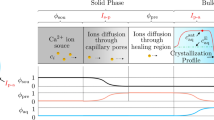Abstract
Magnesium oxychloride (MOC) is a ceramic material with significant fire-resistant properties and growing potential as an alternative building material for passive fire protection systems. The present study examined the magnesium oxychloride 5-phase cure reaction at temperatures from 35 to 55 °C using time-resolved quantitative X-ray diffraction and differential scanning calorimetry to monitor kinetics. The reaction was characterized as a two-step process: dissolution of magnesium oxide followed by crystallization of magnesium oxychloride from the solvated state. With stoichiometric proportions, 37% of the MgO dissolves before the onset of crystallization at a critical amorphous concentration. A maximum crystallinity of 82–84% was achieved for each temperature. Assuming first-order kinetics for both MgO dissolution and MOC crystallization, a kinetic model predicts 42.4 and 26.1 kJ/mol for dissolution and crystallization activation energies, respectively. This model was applied to pilot-scale production and accurately predicts the cure reaction time as a function of cure temperature. In an alternative approach to modeling the cure reaction, the Avrami nucleation and growth model was fit to calorimetric measurements. This model predicts diffusion-controlled, one-dimensional growth with an activation energy of 72.4 kJ/mol, which accounts for both dissolution and crystallization.








Similar content being viewed by others
References
Policastro PP, Tarneja RS (1991) Zinc-containing magnesium oxychloride cements providing fire resistance and an extended pot-life. Patent WO 1991018072 A1
Thompson H (1973) Magnesium oxychloride fireproofing. Patent US3778304 A
Li ZJ, Chau CK (2007) Influence of molar ratios on properties of magnesium oxychloride cement. Cem Concr Res 37(6):866–870
Walling SA, Provis JL (2016) Magnesia-based cements: A journey of 150 years, and cements for the future? Chem Rev 116(7):4170–4204
Tan YN, Liu Y, Grover L (2014) Effect of phosphoric acid on the properties of magnesium oxychloride cement as a biomaterial. Cem Concr Res 56:69–74
Makul N, Agrawal D (2012) Comparison of the microstructure and compressive strength of Type 1 Portland cement paste between accelerated curing methods by microwave energy and autoclaving, and a saturated-lime deionized water curing method. J Ceram Process Res 13(2):174–177
Feigin ME, Choi TS (2011) Magnesium oxide-based construction board. US Patent US7998547 B2
Sugimoto K, Dinnebier RE, Schlecht T (2007) Structure determination of Mg3(OH)5 Cl·4H2O(F5 phase) from laboratory powder diffraction data and its impact on the analysis of problematic magnesia floors. Acta Crystallogr Sect B-Struct Sci 63:805–811
Ramachandran VS (2002) Handbook of thermal analysis of construction materials. Elsevier Science, Amsterdam
Beckett W, Abraham J, Becklake M, Christiani D, Cowie R, Davis G, Jones R, Kreiss K, Parker J, Wagner G (1997) Adverse effects of crystalline silica exposure. Am J Respir Crit Care Med 155(2):761–768
Odler I (2000) Special inorganic cements. Taylor & Francis Group, London
Deng DH (2003) The mechanism for soluble phosphates to improve the water resistance of magnesium oxychloride cement. Cem Concr Res 33(9):1311–1317
Lutterotti L, Ceccato R, Dal Maschio R, Pagani E (1998) Quantitative analysis of silicate glass in ceramic materials by the Rietveld method. Mater Sci Forum 278–281:87–92
Sugimoto K, Dinnebier RE, Schlecht T (2006) Chlorartinite, a volcanic exhalation product also found in industrial magnesia screed. J Appl Crystallogr 39:739–744
Maravelaki-Kalaitzaki P, Moraitou G (1999) Sorel’s cement mortars: decay susceptibility and effect on Pentelic marble. Cem Concr Res 29(12):1929–1935
Deng DH, Zhang CM (1999) The formation mechanism of the hydrate phases in magnesium oxychloride cement. Cem Concr Res 29(9):1365–1371
Ved E, Zharov E, Phong H (1976) Mechanism of magnesium oxychloride formation during the hardening of magnesium oxychloride cement. Zh Prikl Khim 49(10):2154–2158
Bilinski H, Matković B, MAŽURANIĆ C, ŽUNIĆ TB (1984) The formation of magnesium oxychloride phases in the systems MgO–MgCl2–H2O and NaOH–MgCl2–H2O. J Am Ceram Soc 67(4):266–269
Lutterotti L, Bortolotti M, Ischia G, Lonardelli I, Wenk HR (2007) Rietveld texture analysis from diffraction images. Z Kristallogr 26:5
Gražulis S, Daškevič A, Merkys A, Chateigner D, Lutterotti L, Quirós M, Serebryanaya NR, Moeck P, Downs RT, LeBail A (2012) Crystallography open database (COD): an open-access collection of crystal structures and platform for world-wide collaboration. Nucleic Acids Res 40:D420–D427
Sglavo VM, De Genua F, Conci A, Ceccato R, Cavallini R (2011) Influence of curing temperature on the evolution of magnesium oxychloride cement. J Mater Sci 46(20):6726–6733. doi:10.1007/s10853-011-5628-z
Monshi A, Foroughi MR, Monshi MR (2012) Modified Scherrer equation to estimate more accurately nano-crystallite size using XRD. World J Nano Sci Eng 2(03):154
Fruhwirth O, Herzog GW, Hollerer I, Rachetti A (1985) Dissolution and hydration kinetics of MgO. Surf Technol 24(3):301–317. doi:10.1016/0376-4583(85)90080-9
Avrami M (1939) Kinetics of phase change. I General theory. J Chem Phys 7(12):1103–1112
Liu F, Sommer F, Bos C, Mittemeijer E (2007) Analysis of solid state phase transformation kinetics: models and recipes. Int Mater Rev 52(4):193–212
Thomas JJ, Musso S, Prestini I (2014) Kinetics and activation energy of magnesium oxide hydration. J Am Ceram Soc 97(1):275–282
Acknowledgements
Special thanks to Colin McMillen for his training and assistance in XRD measurements and Kim Ivey from her guidance in DSC measurements. We also acknowledge the Center for Advance Fibers and Films at Clemson University, which made use of ERC Shared Facilities supported by the National Science Foundation under Award Number EEC-9731680.
Author information
Authors and Affiliations
Corresponding author
Ethics declarations
Conflict of interest
The authors declare that they have no conflict of interest.
Rights and permissions
About this article
Cite this article
Góchez, R., Wambaugh, J., Rochner, B. et al. Kinetic study of the magnesium oxychloride cement cure reaction. J Mater Sci 52, 7637–7646 (2017). https://doi.org/10.1007/s10853-017-1013-x
Received:
Accepted:
Published:
Issue Date:
DOI: https://doi.org/10.1007/s10853-017-1013-x




